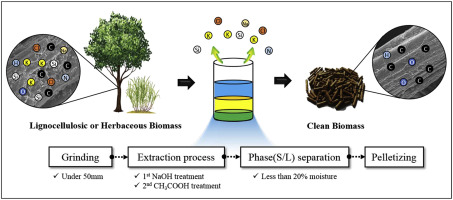当前位置:
X-MOL 学术
›
Atmos. Environ.
›
论文详情
Our official English website, www.x-mol.net, welcomes your
feedback! (Note: you will need to create a separate account there.)
Characterization of PM2.5 and gaseous emissions during combustion of ultra-clean biomass via dual-stage treatment
Atmospheric Environment ( IF 4.2 ) Pub Date : 2018-11-01 , DOI: 10.1016/j.atmosenv.2018.09.011 Young-Joo Lee , Ju-Hyoung Park , Gyu-Seob Song , Hueon Namkung , Se-Joon Park , Joeng-Geun Kim , Young-Chan Choi , Chung-Hwan Jeon , Jong Won Choi
Atmospheric Environment ( IF 4.2 ) Pub Date : 2018-11-01 , DOI: 10.1016/j.atmosenv.2018.09.011 Young-Joo Lee , Ju-Hyoung Park , Gyu-Seob Song , Hueon Namkung , Se-Joon Park , Joeng-Geun Kim , Young-Chan Choi , Chung-Hwan Jeon , Jong Won Choi

|
Abstract Biomass combustion technology is widely considered as an attractive option to remove carbon dioxide emissions and thus could become a viable option for next generation co-combustion power plants with coal. Among biomasses, the faster growing herbaceous biomass (Miscanthus) is relatively inexpensive as a solid fuel but has higher mineral contents (especially high levels of alkali metals) than that of a lignocellulosic biomass (Pitch pine) which leads to ultrafine particle emissions during combustion. This study proposes a dual stage treatment method to extract the inherent minerals in a herbaceous biomass prior to the combustion test. The method consists of an initial treatment with a basic (NaOH) solution and a sequential treatment with an acidic (CH3COOH) solution. To verify the proposed method, we investigated the variations in both the mineral contents and the PM, NOx and SO2 emissions between raw- and treated samples. The experimental results show that sodium, potassium and chloride in the treated herbaceous sample, which are the major minerals that generate ultrafine particles, were removed up to 96.3, 99.4 and 98.3%, respectively. The proposed method is more effective for herbaceous biomasses due to its higher Brunauer–Emmett–Teller (BET) value. Furthermore, the treated herbaceous biomass is even environmentally superior to raw lignocellulosic biomasses currently used in co-combustion power plants with coal in terms of the PM2.5, NOx and SO2 emissions, for which their rejection was measured as 60, 25 and 46%, respectively. These results will help to reduce the energy and costs for De-NOx (selective catalytic reduction, SCR system) and De-SO2 (scrubber) units.
中文翻译:

双级处理超净生物质燃烧过程中PM2.5和气体排放表征
摘要 生物质燃烧技术被广泛认为是消除二氧化碳排放的一种有吸引力的选择,因此可能成为下一代煤混燃电厂的可行选择。在生物质中,生长速度较快的草本生物质(芒草)作为固体燃料相对便宜,但比木质纤维素生物质(松树)具有更高的矿物质含量(尤其是高含量的碱金属),这会导致燃烧过程中排放超细颗粒。本研究提出了一种双阶段处理方法,以在燃烧试验之前提取草本生物质中的固有矿物质。该方法包括使用碱性 (NaOH) 溶液进行初始处理和使用酸性 (CH3COOH) 溶液进行后续处理。为了验证所提出的方法,我们调查了原始样品和处理过的样品之间矿物质含量和 PM、NOx 和 SO2 排放量的变化。实验结果表明,处理过的草本样品中的钠、钾和氯是产生超细颗粒的主要矿物质,分别达到了96.3%、99.4%和98.3%。由于布鲁瑙尔-埃米特-特勒 (BET) 值较高,所提出的方法对草本生物质更有效。此外,在 PM2.5、NOx 和 SO2 排放方面,处理过的草本生物质在环境方面甚至优于目前在与煤混燃的发电厂中使用的原始木质纤维素生物质,其排放量测量为 60%、25% 和 46% , 分别。这些结果将有助于降低脱硝(选择性催化还原、
更新日期:2018-11-01
中文翻译:

双级处理超净生物质燃烧过程中PM2.5和气体排放表征
摘要 生物质燃烧技术被广泛认为是消除二氧化碳排放的一种有吸引力的选择,因此可能成为下一代煤混燃电厂的可行选择。在生物质中,生长速度较快的草本生物质(芒草)作为固体燃料相对便宜,但比木质纤维素生物质(松树)具有更高的矿物质含量(尤其是高含量的碱金属),这会导致燃烧过程中排放超细颗粒。本研究提出了一种双阶段处理方法,以在燃烧试验之前提取草本生物质中的固有矿物质。该方法包括使用碱性 (NaOH) 溶液进行初始处理和使用酸性 (CH3COOH) 溶液进行后续处理。为了验证所提出的方法,我们调查了原始样品和处理过的样品之间矿物质含量和 PM、NOx 和 SO2 排放量的变化。实验结果表明,处理过的草本样品中的钠、钾和氯是产生超细颗粒的主要矿物质,分别达到了96.3%、99.4%和98.3%。由于布鲁瑙尔-埃米特-特勒 (BET) 值较高,所提出的方法对草本生物质更有效。此外,在 PM2.5、NOx 和 SO2 排放方面,处理过的草本生物质在环境方面甚至优于目前在与煤混燃的发电厂中使用的原始木质纤维素生物质,其排放量测量为 60%、25% 和 46% , 分别。这些结果将有助于降低脱硝(选择性催化还原、











































 京公网安备 11010802027423号
京公网安备 11010802027423号